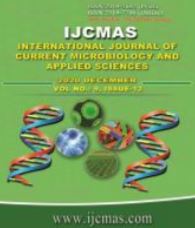


 National Academy of Agricultural Sciences (NAAS)
National Academy of Agricultural Sciences (NAAS)

|
PRINT ISSN : 2319-7692
Online ISSN : 2319-7706 Issues : 12 per year Publisher : Excellent Publishers Email : editorijcmas@gmail.com / submit@ijcmas.com Editor-in-chief: Dr.M.Prakash Index Copernicus ICV 2018: 95.39 NAAS RATING 2020: 5.38 |
Nanotechnology diversified Agriculture, as this technology concepts can be used from nanobiotechnology applications which will influence at the level of molecular markers to DNA sequencing, food processing, storage, to transport, as nanoparticles carry unique properties and miniature dimension, scientists will have to interfere with the matter at atomic and molecular scale as they fall in a transition zone between individual molecules and bulk materials. Seeds can be coated by Silica, Silver, Gold, Chitosan, within a range of 10 – 100 nm, to provide crop protection by acting as protectants or as a carrier for pesticides or other actives, that too a controlled release of Agrochemicals and target specific action, low water soluble insecticides require organic solvents to help solubilise the pesticide which is toxic to the ecosystem as an alternative nanoparticles can be used, thus improving solubility and reducing toxicity. To initiate the Nanoparticles experimental protocol Scientists have synthesised ZNO, CuO, Ag nanoparticles and applied to Fodder Sorghum and Cowpea at TNAU Coimbatore to assess the seed germination and seed health, all of them improved the germination percentage as compared to control. Effect of Nanoparticles was concentration dependant hence at higher doses of TiO2 in sorghum enhanced the germination, ZnO and CuO improved the root/shoot ratio in sorghum. In case of cowpea, ZnO and CuO nanoparticles show significant influence on root/shoot ratio. Ag Nanoparticles act as a strong antimicrobial agents, apart from that nanobiosensors can also be used for tracking the plants moisture content, temperature, RH, and also we can have a closer look of the host-parasitic interaction at molecular level .Some of the hurdles include, soil interaction, toxicity, eco-toxicological implications, formation of free radicals leading to DNA damage.
 |
 |
 |
 |
 |